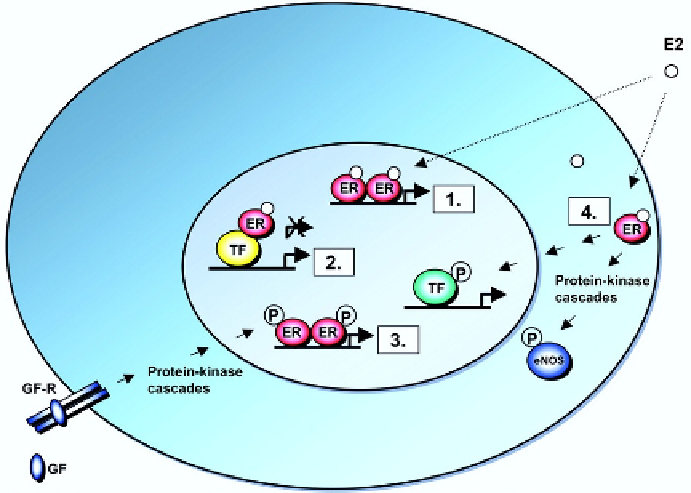Biology Reference
In-Depth Information
Figure 2.27
Schematic illustration of ER signaling mechanisms. (1) Classical mechanism
of ER action. Nuclear E2-ERs bind directly to EREs in target gene promoters. (2) ERE-
independent genomic actions. Nuclear E2-ER complexes are tethered through protein-protein
interactions to a TF complex that contacts the target gene promoter. (3) Ligand-independent
genomic actions. Growth factors (GFs) activate protein-kinase cascades, leading to
phosphorylation (P) and activation of nuclear ERs at EREs. (4) Nongenomic actions.
Membrane E2-ER complexes activate protein-kinase cascades, leading to altered functions
of proteins in the cytoplasm, or regulate gene expression through phosphorylation (P) and
activation of a TF (
Björnström and Sjöberg, 2005
).
a specific gene. A number of hormones and other inducers that have smaller molecu-
lar size are able to pass through the cell membrane and bind to their specific recep-
tors in the cytoplasm or in the cell nucleus.
Let us illustrate the mechanisms of gene expression through cell membrane
receptors and nuclear receptors with a simple example of the activation of estrogen-
inducible genes by E2 and growth factors. The binding of E2 to its nuclear receptor
ecdysone receptor (ER) in the cell nucleus causes a change in the receptor confor-
mation, which facilitates the recruitment of coactivators (
Figure 2.27
). In this form,
after dimerization, the complex binds an estrogen response element (ERE) in the
regulatory sequence of E2-induced genes. E2 can also bind a TF complex before
binding the ERE. In another mechanism, E2 binds its receptor in the cytoplasm and,
from there, activates a signal cascade. A number of growth factors, via signal cas-
cades, can also activate proteins that bind the ER in the nucleus and in this form bind
ERE in estrogen-induced genes (
Björnström and Sjöberg, 2005
).

Search WWH ::

Custom Search